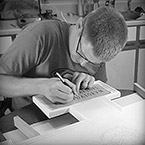About the Studio
The Lutheran church has well earned its reputation as "the singing church," but we sometimes forget that God's gift of visual art can be an equally effective vehicle of the gospel. Scapegoat Studio exists to provide artistic services (primarily) to Lutheran churches. Founder Jonathan Mayer works with congregations to develop tasteful, historically informed, and theologically rich artwork that will proclaim the crucified and risen Christ to future generations.
Why a scapegoat? The scapegoat is one of many biblical "pictures" of Christ. The sins of the people were symbolically placed upon the goat's head, and the animal was sent away into the wilderness to die. In like fashion, our sins were placed on Christ as he was nailed to the cross, and dying there, he carried them to the grave once and for all. There are many other biblical pictures, or types, of Christ: the Passover lamb, the sign of Jonah, and the bronze serpent, to name a few. Like those biblical types, Scapegoat Studio aims to clearly proclaim Christ's redemptive work for all.
- Contact
- Email :

- Phone :

Artist's Statement
My journey towards making sacred art began during childhood. I grew up in a Nebraska suburb, where I was self-taught for many years. My grandfather, a Lutheran pastor, often tapped me for drawings that he could insert into his printed sermons. Bible stories, parables, and apocalyptic visions provided me with endless inspiration. Even though I grew up in a church that largely neglects its artistic heritage, those sermon illustrations instilled in me the notion that the Christian faith begs to be expressed visually.
That notion was reinforced in college, when I received my first formal art training, including surveys of Western art history—a subject that inspired and fascinated me. When I had the opportunity to visit Italy in a capstone art history course, I gathered together my savings and went. Describing it as life-altering would be an understatement. In ten days, Venice, Rome, Florence, and Ravenna offered up a buffet of some of the most sublime sacred works ever created. It completely altered my perspective on art and beauty in the Christian church—and suggested that I had a role to play in it.
There is something both exhilarating and humbling about submitting one's work to a higher purpose—that of pointing to Christ. That was the work of John the Baptist: "He must increase, but I must decrease" (Jn 3:30). Self-denial goes against both the grain of contemporary culture and against human nature. We can only do it (imperfectly) by the grace of God. But when one sets out to proclaim the message, rather than to project one's subjective emotional experiences, the visual arts become a ready medium for proclaiming God's goodness to mankind through his Son, Jesus. As daunting as that vocation may be, I take comfort in the fact that I am travelling a well-worn path. I have the privilege of studying work by countless masters, and bearing witness to the same truths that they did. God worked miracles of faith through their hands, and my prayer each day is that He may work through mine.
Biography
 Jonathan Mayer was born and raised in Omaha, Nebraska. As a child, he was always drawing, and spent many long hours in the office of his grandfather illustrating Bible stories. He was self-taught until attending Bethany Lutheran College in Minnesota. He earned a BA in studio art in 2007, and began work as a freelance illustrator immediately thereafter. In 2011 he graduated with an MFA in illustration from Savannah College of Art and Design. He taught Art History and Fundamentals at Concordia University Nebraska from 2012-2013, and taught online art classes for six years at Wittenberg Academy. He is happily employed as a stained glass designer for Willet Hauser Architectural Glass. He lives in Cochrane, Wisconsin with his wife, Emily, and their five children.
Jonathan Mayer was born and raised in Omaha, Nebraska. As a child, he was always drawing, and spent many long hours in the office of his grandfather illustrating Bible stories. He was self-taught until attending Bethany Lutheran College in Minnesota. He earned a BA in studio art in 2007, and began work as a freelance illustrator immediately thereafter. In 2011 he graduated with an MFA in illustration from Savannah College of Art and Design. He taught Art History and Fundamentals at Concordia University Nebraska from 2012-2013, and taught online art classes for six years at Wittenberg Academy. He is happily employed as a stained glass designer for Willet Hauser Architectural Glass. He lives in Cochrane, Wisconsin with his wife, Emily, and their five children.
- Presentations
- Beauty in Education - 2019
- Beauty in the Beheld - 2015
- Art Wars - 2014
- God is in the Details - 2013
- Vehicles of the Gospel - 2012
- MFA Thesis: Resurrecting Liturgical Art - 2011


